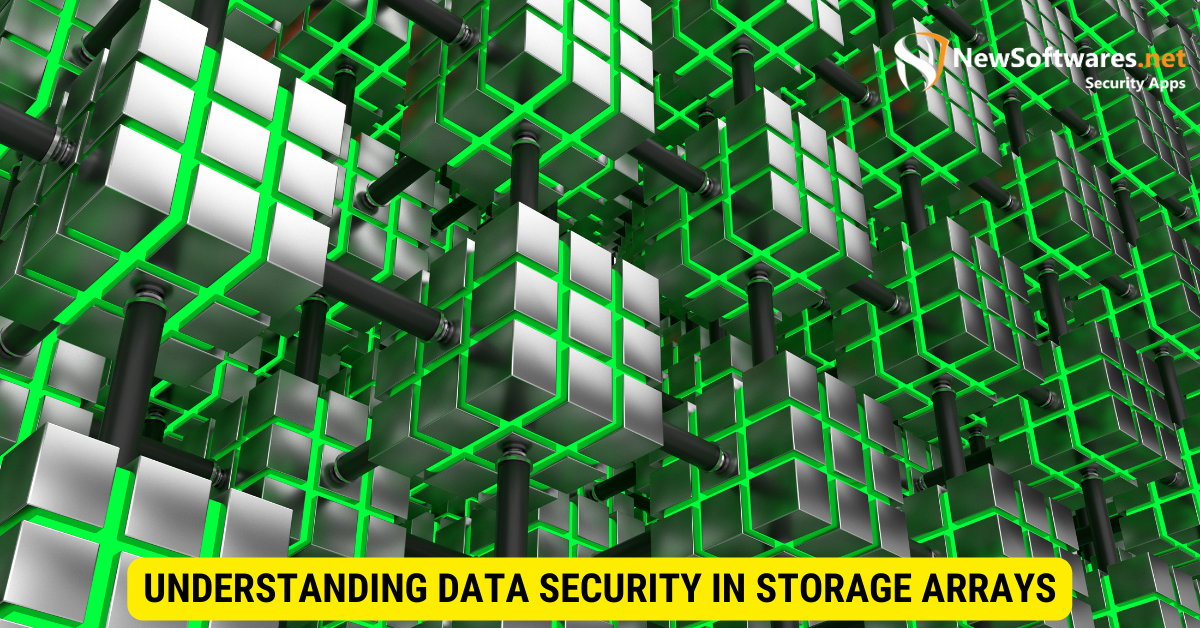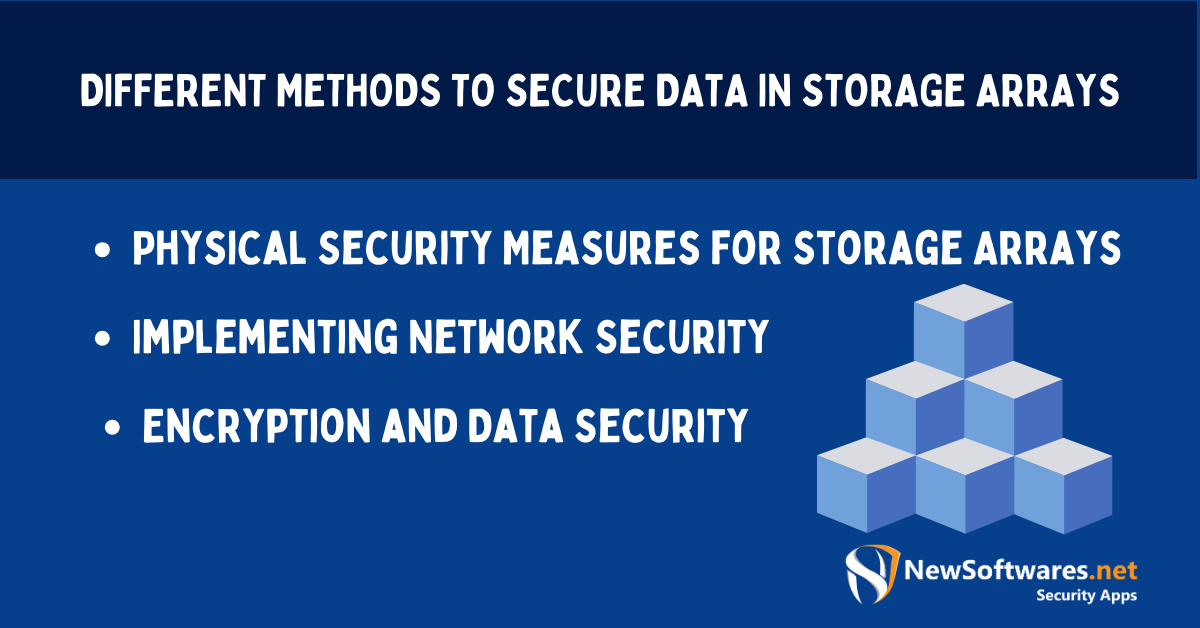Data encryption, access controls, and RAID configurations are some methods that provide security to data in a storage array
In today’s digital age, ensuring data security is of utmost importance. As businesses and individuals rely more on storage arrays to manage and store their data, it becomes crucial to have adequate security measures in place. But what exactly allows you to provide security to the data contained in a storage array? Let’s delve more profound into this topic and understand the various aspects of data security in storage arrays.
Understanding Data Security in Storage Arrays

Data security in storage arrays is vital because it safeguards sensitive information from unauthorized access, modification, or loss. With ever-increasing cyber threats, protecting valuable data has become a top priority for organizations.
In today’s digital age, where data breaches and cyberattacks are on the rise, establishments must take active measures to confirm the security of their storage arrays. By implementing robust data security practices, establishments can mitigate the risks associated with unauthorized access, data manipulation, and potential financial or reputational damages.
The Importance of Data Security in Storage Arrays
Data security in storage arrays plays an important role in maintaining the confidentiality, integrity, and availability of crucial information. It ensures that only authorized individuals can interact and manipulate the data, reducing the risk of data breaches and potential financial or reputational damages.
When sensitive information, such as customer data, intellectual property, or financial records, is stored in storage arrays, it becomes a prime target for malicious actors. These actors may attempt to exploit vulnerabilities in the storage system to gain unauthorized access and misuse the data for their gain.
Organizations can defend against these threats by implementing robust data security measures. This includes implementing access controls, encryption techniques, and other security mechanisms to protect stored data in storage arrays.
Key Concepts in Data Storage and Security
Before diving into the various methods of securing data in storage arrays, it is essential to understand some key concepts. These concepts enhance your knowledge and assist in making informed decisions regarding data security.
Data Classification: Properly categorizing data based on sensitivity and importance enables organizations to allocate appropriate security measures. Organizations can rank their security efforts and allocate resources by classifying data into different categories. For example, highly sensitive data may require stronger encryption and access controls than less sensitive information.
Access Control: Implementing access controls allows organizations to define who can access certain data and what actions they can perform. By granting access privileges based on job roles and responsibilities, organizations can ensure that only authorized individuals can access specific data. Access controls can be implemented through user authentication, role-based access control (RBAC), and multi-factor authentication (MFA).
Data Encryption: Encrypting data adds an extra layer of protection by encoding it in a way only authorized parties can understand. Encryption transforms data into an unreadable format and can only be decoded by consuming a decryption key. This safeguards that even if an unauthorized individual gains access to the data, they cannot understand or manipulate its contents.
Moreover, encryption techniques such as symmetric, asymmetric, and hashing algorithms provide organizations with different data security options. Each encryption method offers varying levels of security and complexity, allowing organizations to choose the most suitable encryption technique based on their needs.
Understanding these key concepts is crucial for organizations to make informed decisions regarding data security in storage arrays. By applying these concepts effectively, organizations can enhance the security of their data and mitigate the risks related to unauthorized access, data breaches, and potential financial or reputational damages.
Different Methods to Secure Data in Storage Arrays

Now that we have a basic understanding of data security let’s explore different methods that can be employed to secure data in storage arrays.
Data security is critical for organizations that store valuable and sensitive information. With the increasing frequency of data breaches and cyber-attacks, it is imperative to implement robust security measures to protect data in storage arrays.
Physical Security Measures for Storage Arrays
Physical security measures focus on protecting the physical infrastructure of the storage arrays. This includes securing data centers, controlling access to server rooms, and employing surveillance systems. These measures prevent unauthorized physical access and theft of storage devices.
Data centers often have advanced security systems, including biometric access controls, CCTV cameras, and alarm systems. Access to server rooms is restricted to authorized personnel only, and strict protocols are followed to monitor and track individuals entering and exiting these areas.
Furthermore, storage arrays can be housed in secure cabinets or racks to prevent tampering or theft. These cabinets may have additional features like locking mechanisms or reinforced construction to provide an extra layer of physical security.
Implementing Network Security
Network security ensures that data communication between storage arrays and other devices remains secure. It involves setting up firewalls and intrusion detection systems and implementing secure protocols such as VPNs (Virtual Private Networks).
Firewalls are a barrier between the storage arrays and external networks, monitoring and controlling incoming and outgoing network traffic. Intrusion detection systems help identify and respond to unauthorized attempts to access or manipulate data in the storage arrays.
Virtual Private Networks (VPNs) create a secure and encrypted connection between remote devices and storage arrays. This ensures that data transmitted over the network remains confidential and protected from interception by malicious actors.
Network security measures may also include implementing strong verification mechanisms, such as two-factor authentication, to prevent unauthorized access to the storage arrays.
Encryption and Data Security
Encryption is a powerful technique to protect data at rest and in transit. By converting data into an illegible format, encryption renders it useless to unauthorized individuals. Employing strong encryption algorithms and secure key management practices enhances data security.
Data at rest refers to stored in the storage arrays when not used. Encryption can be applied to these stored data to ensure that even if the storage devices are compromised, the data remains unreadable without the decryption key.
Data in transit refers to data being transferred between storage arrays and other devices. Encrypting the data during transmission prevents eavesdropping and unauthorized access.
Modern storage arrays often incorporate hardware-based encryption capabilities, which offload the encryption process from the servers, ensuring efficient and secure data protection. Additionally, implementing secure key management practices, such as using strong and unique encryption keys, further enhances the overall security of the storage arrays.
By integrating a blend of tangible security strategies, network security procedures, and encryption methodologies, businesses can notably amplify the safeguarding of their data housed in storage arrays. Consistently refreshing and assessing these security approaches is vital to proactively counter new vulnerabilities and guarantee the sustained security of critical data.
Detailed Analysis of Security Measures
Having explored various methods, let’s now evaluate the advantages and disadvantages of each security approach.
Concerning physical security measures, they offer a robust defense against tangible risks like theft, vandalism, and unauthorized entry. Deploying surveillance systems, security personnel, and access controls substantially mitigates the possibility of physical breaches. Nevertheless, these measures entail significant implementation and maintenance costs. Organizations must factor in expenses related to the procurement and installation of security equipment, recruitment and training of security staff, and ongoing upkeep and enhancements to ensure their continued efficacy.
Conversely, network security mechanisms prioritize safeguarding data during its transmission. Implementing firewalls, intrusion detection systems, and virtual private networks (VPNs) aids in shielding sensitive information from illicit access and cyber assaults. These strategies excel at thwarting data breaches and upholding data integrity and confidentiality. However, it’s worth noting that network security methods might introduce added latency. The examination and filtration of network traffic can decelerate data transmission—a concern for entities necessitating instantaneous communication or maintaining high-performance requisites.
Encryption stands as another pivotal security measure that safeguards data confidentiality. Through encryption, organizations can shield data from unauthorized access, even if interception occurs during transmission or when stored on compromised devices. Encryption algorithms, exemplified by the Advanced Encryption Standard (AES), furnish robust security. Yet, encryption mandates diligent key management. Loss or compromise of encryption keys could result in data loss or unauthorized entry. Hence, organizations must establish sturdy key management protocols, entailing secure storage, routine key rotation, and access controls, to forestall such eventualities.
Case Studies of Security Measures in Action
Examining real-world case studies can offer valuable insights into the effectiveness of different security measures. Organizations can gain inspiration and learn from past mistakes by studying successful implementations to make better-informed decisions.
One notable case study is the security measures implemented by a multinational financial institution. They invested in state-of-the-art physical security systems, including biometric access control, surveillance cameras with facial recognition capabilities, and secure vaults with multiple layers of access control. These measures significantly reduced the risk of physical breaches and ensured the safety of their client’s assets. However, the organization faced challenges in managing the costs associated with these security measures. They had to allocate a significant portion of their budget for the initial implementation and ongoing maintenance of the systems.
In another case study, a technology company focused on network security measures to protect its sensitive intellectual property. They implemented a combination of next-generation firewalls, intrusion prevention systems, and VPNs to secure their network infrastructure. These measures successfully prevented unauthorized access and cyberattacks, ensuring the confidentiality and integrity of their valuable data. However, the company experienced latency issues due to the network security systems’ intensive inspection and filtering processes. They had to fine-tune their configurations and invest in high-performance hardware to mitigate these latency concerns.
Lastly, a healthcare organization implemented encryption as a security measure to protect patient data. By encrypting sensitive medical records and personal information, they ensured that even if the data were compromised, it would remain unreadable and useless to unauthorized individuals. However, they faced challenges in key management. At one point, a staff member accidentally deleted a crucial encryption key, losing access to significant patient data. This incident highlighted the importance of robust key management practices, including regular backups and secure storage of encryption keys.
Future Trends in Data Security for Storage Arrays
As technology continues to evolve, so do the threats to data security. It is vital to stay ahead of the curve and anticipate future trends in data security for storage arrays.
Emerging Technologies in Data Security

New technologies, such as blockchain and secure multi-party computation, present promising solutions for data security in storage arrays. These emerging technologies aim to provide enhanced protection and transparency for sensitive data.
Predicted Changes in Data Security Practices
With the increasing adoption of cloud storage, hybrid environments, and edge computing, the data security landscape is bound to change. Organizations must adapt their security practices to accommodate these new paradigms and mitigate emerging risks.
Choosing the Right Security Measures for Your Storage Array
Choosing the right security measures for your storage array requires careful consideration of various factors.
Factors to Consider When Choosing Security Measures
Some factors to consider include the sensitivity of the data, regulatory compliance requirements, budget constraints, and the likelihood of threats. Organizations can tailor their security measures to suit their specific needs by evaluating these factors..
Key Takeaways
- Data encryption transforms data into unreadable code without the correct decryption key.
- Access controls restrict who can view or modify data.
- RAID configurations can protect against data loss due to hardware failures.
- Regular backups are essential for data recovery.
- Combining multiple security methods can provide layers of protection.
FAQs
Q: Is encryption enough to secure my storage array?
A: Robust encryption is best combined with other security measures for comprehensive protection.
Q: What is RAID, and how does it secure data?
A: RAID stands for Redundant Array of Independent Disks. It uses multiple hard drives to ensure data availability even if one drive fails.
Q: How often should I back up my storage array?
A: Ideally, regularly, depending on how often the data changes, or at least weekly.
Q: What are access controls?
A: They determine who can access data, ensuring only authorized individuals have access.
Q: Can data still be retrieved if a storage array is damaged?
A: Data recovery might be possible depending on the damage and the security measures in place, but there’s no guarantee.
Final Thoughts on Data Security in Storage Arrays
Data security in storage arrays is crucial to protect valuable information from potential risks. It is an ongoing process that requires constant evaluation and improvement. Organizations can safeguard their data and maintain a secure environment by staying updated with the latest security advancements and implementing appropriate measures.
